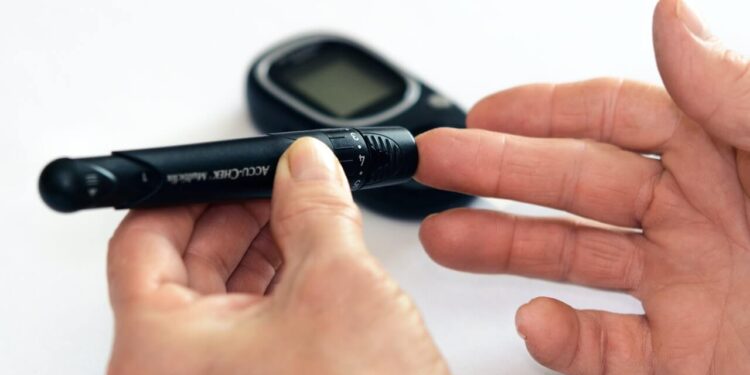Some of the early signs of diabetes include frequent urination and increased thirst. You should consult your doctor if you suspect you have any of these signs.
KAMPALA | NOW THEN DIGITAL — There are several signs of diabetes. You may notice frequent urination, dark patches of skin, and fatigue. Your body isn’t getting the energy it needs from food.
- For example, you might experience frequent urination, excessive thirst, dry mouth and itchy skin. These signs usually occur in people with uncontrolled diabetes.
- Your skin may also become dry or itchy, which can be a sign of increased blood sugar. Diabetes also leads to recurrent infections, such as yeast or bacteria feeding on the glucose in the blood.
- Several other symptoms of diabetes can be subtle and may not be readily apparent. Some symptoms are common in both Types, and some of them can overlap with the symptoms of other chronic diseases.
- You should consult your doctor if you suspect you have any of these signs. If you have a frequent thirst, you may have diabetes mellitus. Excessive thirst can be a sign that your blood sugar level is out of balance.
You may also experience increased hunger. High blood sugar levels affect circulation, which can hinder the healing process.
For this reason, wounds can heal slowly or not at all. Additionally, people with diabetes are prone to yeast infections, as yeast feeds on glucose.

Excessive thirst

If you’re constantly thirsty, you may be suffering from diabetes. People with type 1 diabetes have no insulin, which means that their bodies don’t produce enough of it.
This means that glucose stays in the blood, preventing the body from flushing out excess blood sugar in the urine.
People with type 2 diabetes produce insulin but it doesn’t get into the cells properly. This leaves glucose in the blood, causing excessive thirst and excessive urine output.
Diabetes results in excessive thirst, and the body’s response is often insulin resistance, resulting in high blood sugar levels.
In addition to increased thirst, type 2 diabetes patients experience frequent urination. Excess glucose exits the body through the urine, drawing water from the blood and causing the person to feel more thirsty than usual.
Excessive thirst can also lead to nerve damage and numbness. If you have symptoms of this condition, see your healthcare provider right away. You should also report any new symptoms you have to your diabetes team.
In addition to age, there are many risk factors that increase your risk of developing diabetes. To limit your risk, maintain a healthy lifestyle and watch your blood sugar levels.
People with diabetes may experience increased thirst without experiencing other symptoms. This is called polydipsia and is a common symptom of diabetes.
If you notice that you feel thirsty frequently and have a high blood sugar level, you should consult with your doctor. Your doctor may need to adjust your medication or change your lifestyle to control your diabetes symptoms.
Your diabetes doctor will give you guidance on your diet and exercise habits. If you continue to experience excessive thirst after a short period of time, you may be suffering from diabetes.
Fatigue

If you’re suffering from diabetes, you’ve probably noticed how fatigue can negatively impact your everyday life. The constant need to manage blood sugar levels and other aspects of diabetes can lead to psychological stress and burnout.
Studies have shown that people with diabetes are more prone to depression than those without it. Depression can set in once you’ve been diagnosed with diabetes for a while. In such cases, fatigue can be a symptom of depression, and you should speak to your doctor.
One possible cause of fatigue is improperly managed blood sugar. High blood sugar can cause poor circulation and prevent the body’s cells from receiving proper fuel.
High blood sugar may even lead to inflammation of the blood vessels, which releases monocytes into the brain, causing fatigue. High blood sugar levels can also lead to an increased risk of seizures and confusion.
Diabetes can also cause fatigue as fatigue is often a symptom of low blood sugar. If you experience frequent bouts of fatigue, it’s important to see a doctor. Your healthcare provider can monitor your diabetes and rule out other conditions that could be causing your fatigue.
Although fatigue is normal for many people with diabetes, a chronic state of fatigue can be very problematic. Finding the cause of your fatigue is critical to maintaining a healthy life.
If you’re concerned about fatigue, make an appointment with your doctor as soon as possible.
The duration of fatigue varies from person to person. Chronic fatigue is more severe and can interfere with daily activities. The duration of fatigue is also greater in those with diabetes than in those with healthy blood sugar levels.
A cross-sectional design study can identify potential determinants, but it can’t determine whether the cause is diabetes or a comorbid condition. However, the study’s limitations should not be a reason for alarm.
Dark patches of skin
Acanthosis nigricans is a classic dermatologic manifestation of diabetes and can affect men and women of all ages. People with diabetes of either type have an increased risk of AN.
It is common among people with darker skin and is disproportionately seen in African Americans, Hispanics, and Native Americans. It can be an early sign of type 2 diabetes, or it may be a symptom of pre-diabetes.
These patches of skin are usually velvety in color and may occur in areas of the body such as the neck, armpits, or groin. While they are not contagious and are not harmful, they may be a symptom of other diabetes-related conditions.
A dermatologist can help determine the cause of your dark patches. If they are widespread, they may be a sign of prediabetes.
Blisters are another common symptom of diabetes. They can form anywhere on the body and resemble the appearance of severe burns. These blisters are often not painful, but they can be extremely painful.
These ulcers are called diabetic dermopathy. They typically form on the legs, buttocks, and trunk, but can also appear on the arms, elbows, and backs of the knees.
Despite the appearance of these skin symptoms, diabetes-related itching is a common symptom. Skin rashes, skin ulcers, and dryness are all symptoms of diabetes.
Diabetics also experience skin infections like Acanthosis nigricans, which are often associated with digestive tract cancer and endocrine system diseases.
Dermatologists can help people with diabetes find solutions for these problems. If left untreated, they may fade with proper diet.
Excessive urination

You might have been wondering if excessive urination is a symptom of diabetes. This condition is often caused by excess blood sugar in the blood and it can affect both the kidneys and bladder.
A urine sample will also be abnormally cloudy or odorous. You might even have an infection without any visible signs, including burning and itching when you urinate.
People with diabetes are more likely to experience infections, such as UTIs and yeast infections.
If you experience frequent urination, you should visit a physician for further diagnosis. This condition can cause dehydration and lead to other complications like diabetic ketoacidosis.
However, if your symptoms are getting worse or are more severe, it is important to see a doctor for a proper diagnosis. In most cases, diabetes can be treated effectively and easily. Excessive urination is a symptom of diabetes.
If you’re having frequent urination, your body is trying to get rid of excess glucose in the blood. Your kidneys are working harder to filter blood glucose, and they spill sugar into the urine.
This sugar feeds bacteria and yeast, and they thrive in high blood sugar levels. In addition to dehydration, frequent urination can also deplete your energy levels.
Excessive urination is one of the most common symptoms of diabetes. But other symptoms of diabetes include excessive thirst and frequent urination.
Symptoms of diabetes can also include loss of sensation and a buildup of pus in the gums. All of these signs are indicators that you should see a doctor as soon as possible.
It’s better to seek treatment than to wait until your blood sugar levels reach dangerous levels.
Lack of energy

The main symptoms of diabetes are fatigue and decreased energy, but lack of energy may also be a symptom of other conditions. Chronic hyperglycemia, or elevated blood sugar levels, can cause the body to use its reserves for energy.
Instead of using glucose from the blood, the body burns fat. This excessive use of energy reserves leads to fatigue. Although better glucose control can help reduce fatigue caused by diabetes, there are other causes for fatigue.
A lack of energy can be a symptom of a number of health problems, including emotional problems. Many people with diabetes experience depression and anxiety, which can further complicate the symptoms of low energy.
Lack of energy can also be a symptom of being overweight, which adds to the problem. If you experience low energy and lack of motivation, speak to your healthcare team to find the underlying problem.
If you have been feeling fatigued for a long time, you may need to consult with a doctor to find out if you have diabetes.
Symptoms of low blood sugar and hypoglycemia are closely related. When a person has low blood sugar, their body is unable to properly fuel their cells, which causes fatigue.
Another cause of low blood sugar is insulin resistance, which prevents the body from producing enough insulin to fuel the cells. When this happens, a person will be extremely tired and have trouble working. This can lead to a person feeling hungry and tired all of the time.
Lack of energy is a common symptom of diabetes and does not need to last. See your healthcare provider for advice. There are several treatment options to help you manage your diabetes and its associated fatigue.
You may be able to overcome fatigue by changing your lifestyle, taking the appropriate medications, or simply being patient and persistent.
In addition to improving your overall health, your healthcare provider will also help you make lifestyle changes to improve your energy levels.
Don’t forget to share our article on ‘signs of diabetes’ if you liked it.
You’re reading nowthendigital.com — which breaks the news about Uganda, Kenya, Nigeria, South Africa and the rest of the world, day after day. Be sure to check out our homepage for all the latest news, and follow NOW THEN DIGITAL on YouTube, Google News, Medium, Twitter, Reddit, Pinterest and Flipboard to stay in the loop.

















